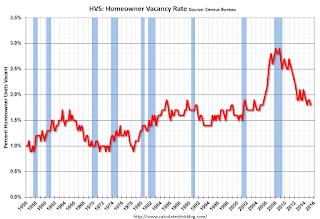This report is frequently mentioned by analysts and the media to track household formation, the homeownership rate, and the homeowner and rental vacancy rates. However, there are serious questions about the accuracy of this survey.
This survey might show the trend, but I wouldn't rely on the absolute numbers. The Census Bureau is investigating the differences between the HVS, ACS and decennial Census, and analysts probably shouldn't use the HVS to estimate the excess vacant supply or household formation, or rely on the homeownership rate, except as a guide to the trend.
 Click on graph for larger image.
Click on graph for larger image.The Red dots are the decennial Census homeownership rates for April 1st 1990, 2000 and 2010. The HVS homeownership rate decreased to 63.4% in Q2, from 63.7% in Q1.
I'd put more weight on the decennial Census numbers - and given changing demographics, the homeownership rate is probably close to a bottom.
 The HVS homeowner vacancy declined to 1.8% in Q1.
The HVS homeowner vacancy declined to 1.8% in Q1. Are these homes becoming rentals?
Once again - this probably shows the general trend, but I wouldn't rely on the absolute numbers.
 The rental vacancy rate decreased in Q2 to 6.8% from 7.1% in Q1.
The rental vacancy rate decreased in Q2 to 6.8% from 7.1% in Q1.I think the Reis quarterly survey (large apartment owners only in selected cities) is a much better measure of the rental vacancy rate, but this does suggest the rental vacancy rate is the lowest in decades.
The quarterly HVS is the most timely survey on households, but there are many questions about the accuracy of this survey.
No comments:
Post a Comment
Note: Only a member of this blog may post a comment.